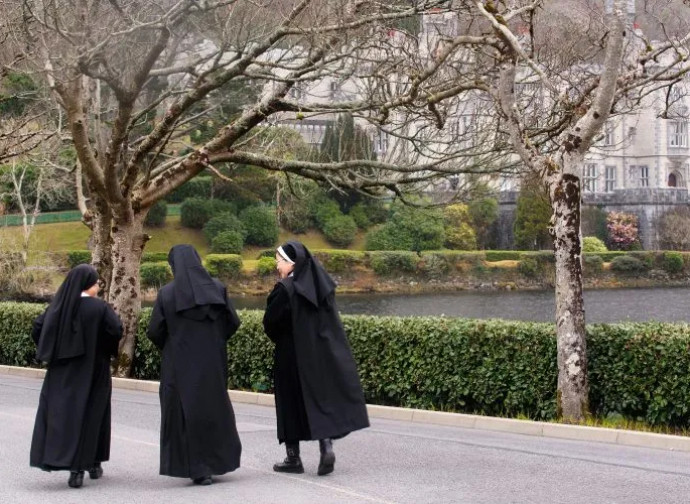Nuns in Ireland, an endangered species
A survey by Irish Catholic reveals that the number of religious women in Ireland has dropped by 50% in just 20 years, and the trend indicates a further collapse. A phenomenon that undermines the system of health and educational services that have been guaranteed for the population since independence.

Perhaps nothing else renders the changing religious landscape in Ireland more obvious than the decline in the numbers of religious sisters. As Europe’s most western nation endures yet another winter where its hospitals seem to be in a permanent crisis mode, ask any local person of a certain age about the time when religious orders were at the fore in managing healthcare.
The late broadcaster for Ireland’s main station RTE Marian Finucane rarely concluded a debate on the health service without observing the hospitals were well run when we had the nuns”. Undoubtedly, the nostalgia for the past was an over-simplification – but it does speak to a time when the presence of religious sisters was appreciated in healthcare and more generally in society.
When the 1961 census was recorded, there were 13,259 nuns in the Republic Ireland. That meant there were more Irish women in religious orders than there were in teaching. Practically ever family had a nun in the family”, be it an aunt, a sister, a cousin and so on. They voluntarily gave up their lives to serve God, the Church and the local communities where they established themselves.
The nuns and sisters were integral to the lives of many communities. Some orders were centred in cities, but many were based in rural towns and villages otherwise ignored by the state. For instance, in Kenmare in the south-west county of Kerry, the Sisters of Nazareth were responsible for two schools and a factory for making lace that they opened specifically to tackle the crippling poverty in the area. Now, 160 years after arriving in the Irish town, the sisters have announced they must withdraw due to declining numbers.
As the recent controversy about the National Maternity Hospital (NMH) evidenced, the baby has been well and truly thrown out with the bathwater and the heroic work of religious women is almost entirely disregarded. The hospital is to be built by the state on land gifted to them by the Sisters of Charity, completely gratis. But, instead of thanking the order for their generosity, the politicians and the media have led a witch hunt against them, alleging all kinds of conspiracies about Church control over state institutions.
And yet where would Ireland be without their work which established the infrastructure that would support the state when it achieved independence from England? Where would it be without the schools, hospitals, hospices and factories they founded? The truth is Ireland would be much worse off.
This remains true even while the hurt remains acutely felt by many people due to the sisters who betrayed their vocation and abused and neglected those in their care. Yet, an often overlooked section of people who share that hurt are the many sisters who never harmed a person but see their past work dismissed and ridiculed.
While many congregations, no longer as visible as in the past after they decided to set aside their distinctive religious habits, stayed and continued working to better the lives of the most vulnerable. They still are, of course – though in much smaller numbers.
As The Irish Catholic newspaper reported February 16, the number of religious women in Ireland has halved since the year 2000. There were 9,031 nuns and sisters across the island of Ireland at the turn of the millennium, but in the last 20 years that has declined to just 4,494. This marks a decline of 50.2%.
The Diocese of Cork and Ross in the south has seen the sharpest decline, falling from 690 religious women in 2000 to just 70 in 2020, down almost 90%. It is followed by Down and Connor in the North (78%), Kerry (68%) and Achonry (63%), a small diocese in the west of Ireland.
Ireland’s largest diocese, the Archdiocese of Dublin, saw the largest drop numerically, down from 1,739 to 1,180 religious women. This marked a fall of 40%. The north-western diocese of Raphoe saw the lowest numerical decline (37), but this was still down 57% since 2000. Galway, Kilmacduagh and Kilnefora saw the lowest decline of just 17.6%, with 14 dioceses facing a decline of more than half in the last 20 years.
This is according to the most recent figures from the 26 dioceses. Half of the figures relate to 2021 and so include the effects of the first year of Covid-19. However, the figures from the other dioceses relate to pre-Covid times and so are expected to drop further when updated statistics are released. Religious orders were hit hard by the virus, particularly for retired members in nursing homes.
Religious women in Ireland have played an integral role in the development of social infrastructure such as schools, hospitals and hospices. Many continue to work quietly in these fields, either as volunteers or as employees of the State and Church in Ireland.
Though These sisters are mostly elderly and will soon have to retire but there few professed women to take their place. The one question that no-one seems to know the answer to is: who will rise to the challenge when these sisters are no longer able? And for the Church in Ireland, the figures highlight that the future of religious life on the land of saints and scholars is very uncertain. Ireland, as historian Dr Bronagh Ann McShane puts it in The Irish Catholic, is at a turning point.




